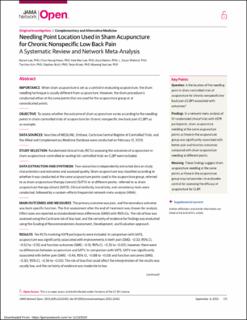| dc.description.abstract | Importance
When sham acupuncture is set as a control in evaluating acupuncture, the sham needling technique is usually different from acupuncture. However, the sham procedure is conducted either at the same points that are used for the acupuncture group or at nonindicated points.
Objective
To assess whether the outcome of sham acupuncture varies according to the needling points in sham-controlled trials of acupuncture for chronic nonspecific low back pain (CLBP) as an example.
Data sources
Searches of MEDLINE, Embase, Cochrane Central Register of Controlled Trials, and the Allied and Complementary Medicine Database were conducted on February 12, 2023.
Study selection
Randomized clinical trials (RCTs) assessing the outcomes of acupuncture in sham acupuncture–controlled or waiting list–controlled trials on CLBP were included.
Data extraction and synthesis
Two researchers independently extracted data on study characteristics and outcomes and assessed quality. Sham acupuncture was classified according to whether it was conducted at the same acupuncture points used in the acupuncture group, referred to as sham acupuncture therapy (verum) (SATV) or at different points, referred to as sham acupuncture therapy (sham) (SATS). Clinical similarity, transitivity, and consistency tests were conducted, followed by a random-effects frequentist network meta-analysis (NMA).
Main outcomes and measures
The primary outcome was pain, and the secondary outcome was back-specific function. The first assessment after the end of treatment was chosen for analysis. Effect sizes are reported as standardized mean differences (SMD) with 95% CIs. The risk of bias was assessed using the Cochrane risk of bias tool, and the certainty of evidence for findings was evaluated using the Grading of Recommendations Assessment, Development, and Evaluation approach.
Results
Ten RCTs involving 4379 participants were included. In comparison with SATS, acupuncture was significantly associated with improvements in both pain (SMD, −0.33; 95% CI, −0.52 to −0.15) and function outcomes (SMD, −0.13; 95% CI, −0.25 to −0.02); however, there were no differences between acupuncture and SATV. In comparison with SATS, SATV was significantly associated with better pain (SMD, −0.45; 95% CI, −0.88 to −0.03) and function outcomes (SMD, −0.30; 95% CI, −0.56 to −0.05). The risk of bias that could affect the interpretation of the results was usually low, and the certainty of evidence was moderate to low.
Conclusions and relevance
In this NMA, sham acupuncture needling at the same points as those in acupuncture was not a true placebo control for assessing the efficacy of acupuncture for CLBP and might underestimate the outcome of acupuncture in clinical settings. | en_US |

